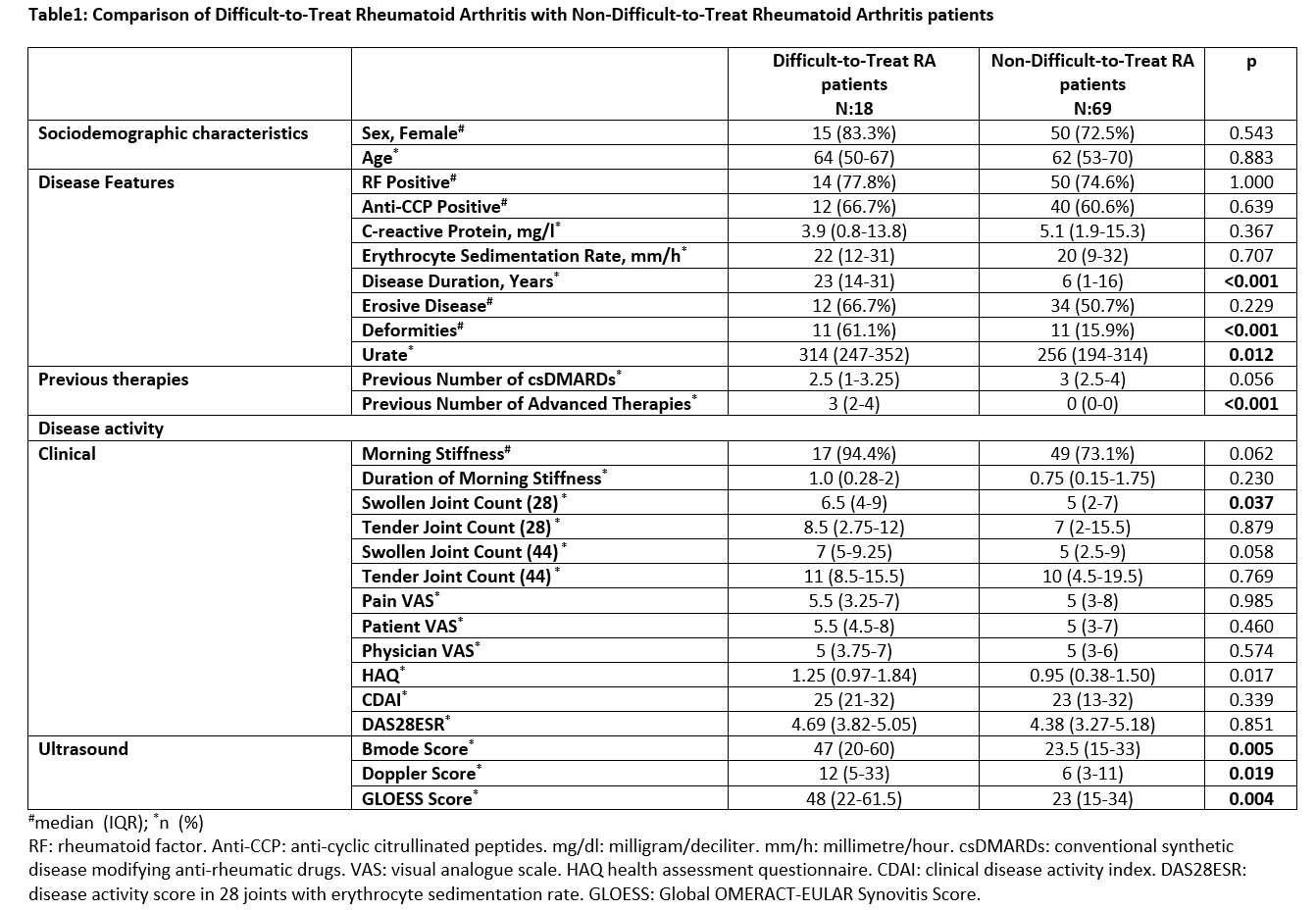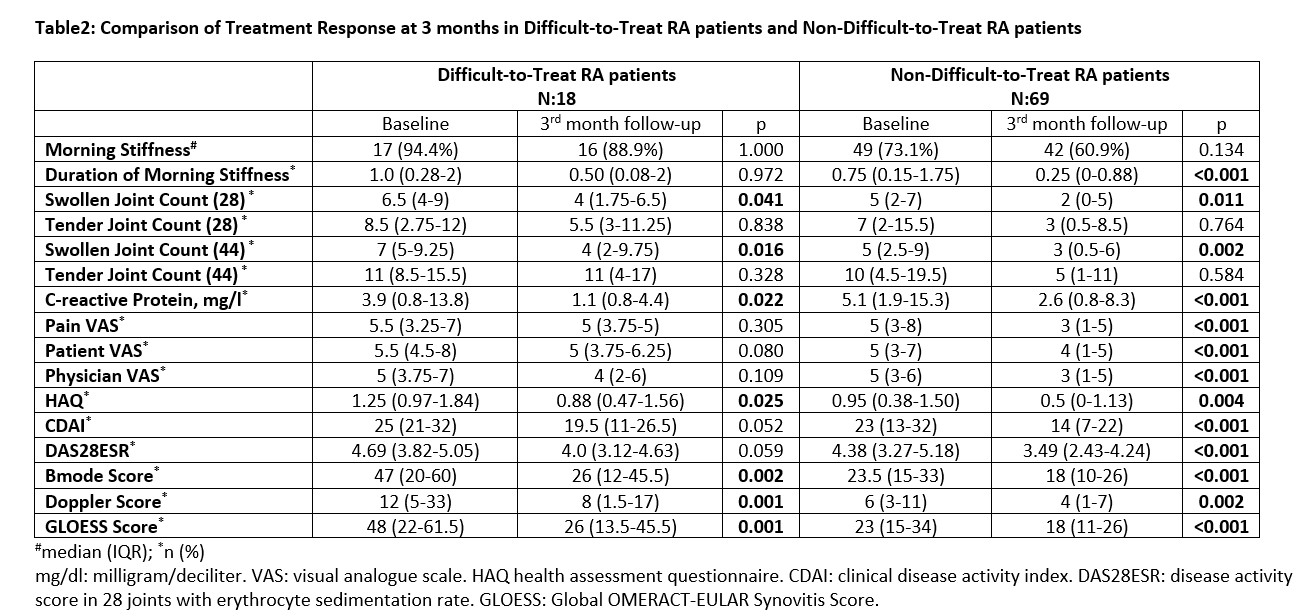Session Information
Date: Saturday, November 16, 2024
Title: Imaging of Rheumatic Diseases Poster I: Inflammatory Arthritis
Session Type: Poster Session A
Session Time: 10:30AM-12:30PM
Background/Purpose: In the era of several advanced therapies and an increasing number of patients with rheumatoid arthritis (RA) who have been failed by multiple therapies, a better understanding of Difficult-to-Treat (D2T) RA is essential and timely. In this analysis, we aimed to explore the D2T RA patient phenotype, by comparing the clinical features, comorbidities, and ultrasonographic features with non-DT2 RA at baseline. We also explored their response to therapies at 3 months.
Methods: Patients were recruited from the ORCHESTRA (Ottawa Rheumatology CompreHEnSive Treatment and Assessment) Clinic, where all patients with inflammatory arthritis who are about to initiate a new advanced therapy are assessed following a standardized protocol including disease features, medications, comorbidities, and clinical disease activity measures. In addition, a protocolized ultrasound (US) of 36 joints is conducted at baseline and three-month intervals, until reaching clinical remission. All joints are scored using the Global OMERACT-EULAR Synovitis Score (GLOESS). For this analysis, the D2T RA definitions were based on the EULAR definition. (1) D2T and non-D2T RA patients were compared for their baseline characteristics and disease activity as well as their responses to the advanced therapies at month 3.
Results: Among 87 RA patients, 18 (20.7%) fulfilled the definition of D2T RA at baseline. Demographic characteristics were similar between the two groups, except D2T RA patients having longer disease duration (Table 1). Seropositivity was similar across groups, with numerically more erosive disease in the D2T RA patients (66.7% vs 50.7%). DT2 RA group had significantly more frequent deformities and had higher HAQ scores. There were no differences between groups for the comorbidities, except urate levels being significantly higher in D2T RA patients (Table 1). Regarding the disease activity, D2T RA had significantly higher swollen joint counts (SJC) and numerically higher tender joint counts, CDAI and DAS28ESR scores. D2T RA patients had higher US scores for synovitis, Doppler signals and overall GLOESS scores. (Table 1) At follow-up visit, both D2T and non-D2T RA patients had significant reductions in SJC, CRP and HAQ scores. On the other hand, the tender joint counts, patient and physician global assessments and composite indices only showed significant improvements in non-D2T RA, but not in the D2T group. The US scores improved in both groups, both for synovitis and Doppler signals. (Table 2)
Conclusion: We found an overall higher burden of disease activity in the D2T RA group when using more objective measures of disease activity, such as US. Although both D2T and non-D2T RA patients showed significant responses to a new advanced therapy after 3 months on the objective measures of disease activity (SJC and US), the subjective measures responded less in the D2T RA group. These findings highlight the difficulties in assessing and following disease activity while suggesting an additive beneficial role for US in the monitoring of response to therapy in D2T RA.
To cite this abstract in AMA style:
Acikgoz S, Sabido-Sauri R, Bayindir Tsechelidis O, Gazel U, Sangwa S, Hepworth E, Aydin S. Subjective and Objective Measures of Disease Activity in Difficult-to-Treat Rheumatoid Arthritis Patients at Baseline and Follow-up After an Advanced Therapy: An Ultrasound Study [abstract]. Arthritis Rheumatol. 2024; 76 (suppl 9). https://acrabstracts.org/abstract/subjective-and-objective-measures-of-disease-activity-in-difficult-to-treat-rheumatoid-arthritis-patients-at-baseline-and-follow-up-after-an-advanced-therapy-an-ultrasound-study/. Accessed .« Back to ACR Convergence 2024
ACR Meeting Abstracts - https://acrabstracts.org/abstract/subjective-and-objective-measures-of-disease-activity-in-difficult-to-treat-rheumatoid-arthritis-patients-at-baseline-and-follow-up-after-an-advanced-therapy-an-ultrasound-study/


